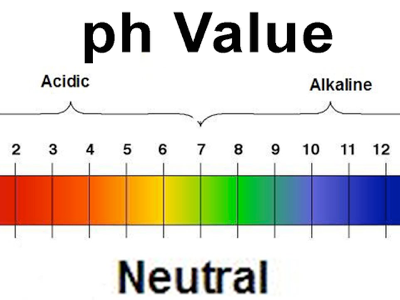How to reduce pH in Aquaponics without so much guess work

Where we are the tap water is literally “liquid rock” with high alkalinity coming out the tap at a pH of 8.2 to 8.5 depending on the time of year. So one of the vexing questions I hear in local DIY circles is “How do I adjust my pH Up or Down without killing my fish? Now there are many ways to accomplish this task. One method is to have water that is already at your desired pH ready to go to replace water that is lost to evaporation. (NOTE: the water in such a replacement tank may be adjusted in the manner below as well) However, I’ve noted that if for whatever reason that can’t be done or there is an emergency (oops left the hose on) here is an additional method for your consideration.
In that fish usually get killed by guess work (dropping the pH to far all at once for example), this is a way that I teach my Jr. College aquaponic classes so they may accurately bring their pH down to wherever they wish. Naturally it will bounce back up depending on the alkalinity of the water several times before it balances but this method takes a lot of the guess work out and it works with whatever concentration or kind of acid you choose to use. It is based off the old chemistry concept of a titration.
First a titration is when we use carefully measured amounts of a known solution to determine the concentration of another. In this case however, instead of determining the concentration, we will use this process to determine how much acid we need to add to increase the concentration of Hydrogen (pH is a measure of how much Hydrogen there is in the water) from a current point to one that is desired.
Second, for this blog I am using the metric system. Scientists do that by habit. Sorry. However to convert, simply click this link and Google will pop up a neat little conversion calculator
Third, this method is intended for use with water that is well aerated so crank the air up before you do this.
INSTRUCTIONS
1. I take two gallons of water from the system in a plastic bucket.
2. I use an eyedropper to drip acid in the water in the bucket testing the water after each drop till it reaches my pH set point say, 7.5. (7.5 is NOT a recommendation, just an example to show you how this works) Usually that is between 3 and 6 drops depending on how strong the acid is and the original pH of the water. Again, ours is very alkaline (Mesa Az).
3. Each drop of acid has an approximate volume of 0.05 milliliters. So for this example, 6 drops would have a volume of 0.30 milliliters.
4. So if it takes 6 drops of acid (0.30 ml) to bring 2 gallons of water down to pH 7.5 then it takes 0.15 ml to bring 1 gallon of water down to pH 7.5.
5. I then multiply 0.15 ml x the amount of water in my system in gallons to get the amount of acid I need. So say I have 1,000 gallons of water, so it would be 1,000 x 0.15 ml = 150 ml or just over 5 oz.
Again this will work every time no matter what kind of acid you use or how concentrated it is. (NOTE: Only use an acid type that has been demonstrated safe for aquaponics when used properly.) Naturally because of all the carbonates in our water we usually have to do this a few times over a few days time until they (the carbonate buffers) saturate so our water will stay at 7.5. Then in our hot climate we have to add water, which messes the whole thing up. However as a farmer you will learn to streamline this process so with works best for you.
Final point. pH is a touchy matter. The blog only tells you a way to change it precisely to the point you desire at that moment. It does not cover how much to change it by at any one time That will be the subject of a later blog. (Small pH changes are always best when necessary and one must always take great care when changing the pH of a tank or entire system with fish in it).
I hope this helps. Over time if your biofiltration is working correctly the as the fish get larger the increasing conversion of Ammonia to Nitrate begins to release enough hydrogen in to the water to bring the pH down without adding additional acid.
Related news
 Simple Settling Chambers Aid Solids Management In Biofloc System
Simple Settling Chambers Aid Solids Management In Biofloc System A study that examined the effects of removing suspended solids using side-stream settling cham-bers in a superintensive biofloc shrimp system found the chambers
 Turbidity Removal From Pond Waters
Turbidity Removal From Pond Waters Eliminate sources of turbidity in culture ponds and use coagulants only if the turbidity remains.
 Erosion, Sedimentation in Earthen Aquaculture Ponds
Erosion, Sedimentation in Earthen Aquaculture Ponds Embankments made of heavy clay soils must have adequate side slopes or they will slip.